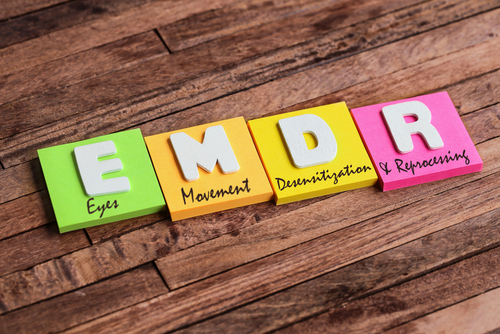
Psychologist Francine Shapiro developed Eye Movement Desensitization and Reprocessing (EMDR) therapy in 1987. According to the EMDR Research Foundation, “EMDR is an integrative psychotherapy approach that has been extensively researched and proven effective for the treatment of trauma. EMDR therapy includes a set of standardized protocols that incorporate elements from many different treatment approaches.” Though it was initially developed as a means to treat individuals suffering from anxiety, posttraumatic stress disorder (PTSD), panic and/ or trauma, research has indicated that it has since become an effective means of treatment for individuals diagnosed with substance use disorder and other mental health ailments. EMDR incorporates a variety of principals from other therapeutic modalities, including behavioral therapy and cognitive behavioral therapy (CBT).
EMDR Basics
EMDR is based on the notion that physiological symptoms occur as a result of trauma or challenging experiences overwhelming the brain’s natural ability to heal. EMDR works to relieve one’s brain of certain coping mechanisms that have been developed to help an individual cope with a traumatic event or events. EMDR therapy facilitates the healing process through bilateral stimulation where an individual can revisit a previously experienced trauma and learn to re-process and reintegrate it in a way that is both healthy and disarming, alleviating physiological stress. EMDR is an eight-stage therapeutic process, which includes:
- Initial history discovery and treatment planning
- Preparation
- Assessment
- Desensitization
- Installation
- Body scan
- Closure
- Reevaluation
A typical EMDR session lasts between sixty to ninety minutes long. EMDR can be used on its own or used to supplement other types of therapy.
EMDR Therapy In LA
There are many highly trained EMDR practitioners in Los Angeles, California, which for some can make the search for locating a therapist, seem like an overwhelming feat. There are fantastic online resources that offer curated lists containing qualified EMDR providers, serving the Los Angeles area (e.g. Psychology Today). Often the best recommendations come by word of mouth. An excellent place to start your search is to consult your primary care physician as they should be able to point you in the right direction, and many may even offer recommendations from within their professional network. For some, openly discussing the need for a mental health professional with family and friends may not be comfortable, but for those that are open to broaching the topic with outsiders, asking family and friends for recommendations could be beneficial. It is advantageous to be mindful of the fact that even though EMDR practitioners follow a set of standardized EMDR protocols, each therapist practices with his or her own distinct style.
Disclaimer:
The information above is provided for the use of informational purposes only. The above content is not to be substituted for professional advice, diagnosis, or treatment, as in no way is it intended as an attempt to practice medicine, give specific medical advice, including, without limitation, advice concerning the topic of mental health. As such, please do not use any material provided above as a means to disregard professional advice or delay seeking treatment.

